Contents
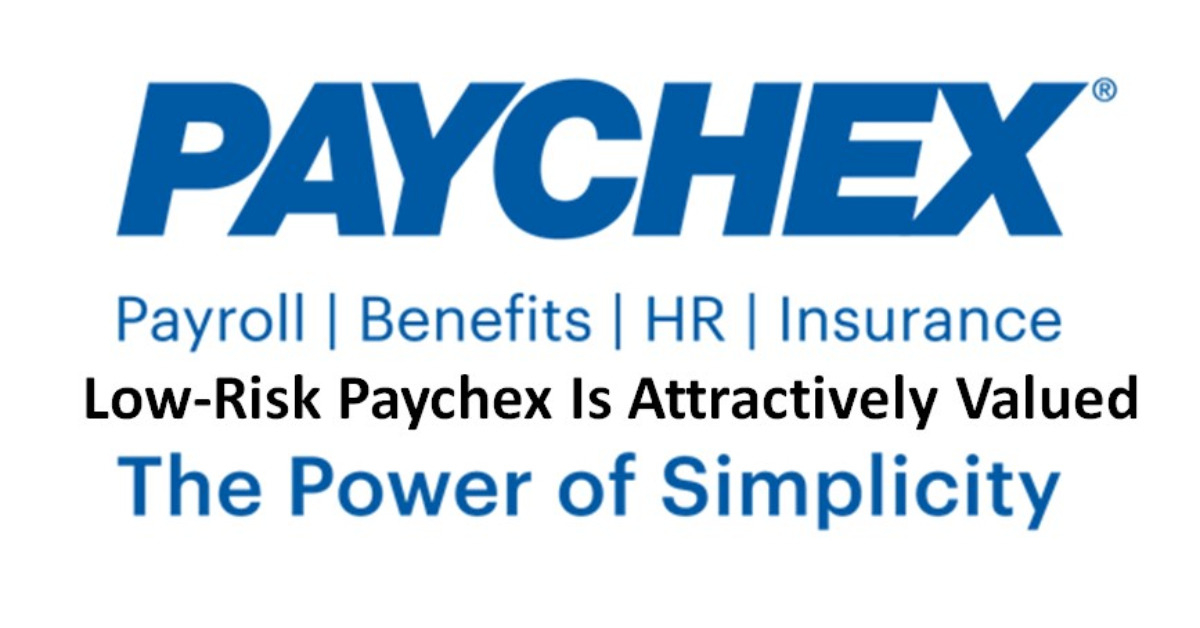
I consider low-risk Paychex (PAYX) to currently be attractively valued.
I last reviewed this holding in my March 30, 2023 post at which time Q3 and YTD2023 results had just been released. With the release of its Q4 and FY2023 results and FY2024 outlook, I briefly revisit this holding.
Business Overview
Although I provide a Business Overview in prior PAYX posts, I strongly encourage you to read Part 1 of the FY2022 Form 10-K to gain a good understanding of the company; the FY2023 Form 10-K and Proxy Statement are expected to be available in late July.
Financial Review
Q4 and YTD2023 Results
On June 29, PAYX issued Q4 and FY2023 results and FY2024 outlook (Form 8-K and Earnings Presentation).
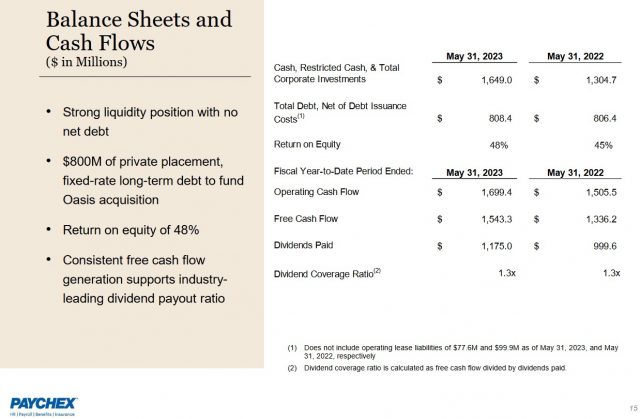
Source: PAYX - Q4 2023 Earnings Presentation
In FY2013, PAYX's total annual revenue was ~$2.326B. In FY2023, total revenue was just over $5B.
Total expenses increased ~7% in FY2023 versus FY2022. This expense growth was largely attributable to higher headcount, wage rates and general costs to support growth in the business.
FY2023 cash flow from operations was $1.7B, an increase of 13% from the prior year. This was driven by higher net income and changes in working capital.
FY2023 free cash flow (FCF) was $1.5B or 50% YoY.
PAYX benefits from having client funds on deposit from which it can generate additional income. A rising interest rate environment benefits PAYX's short-term investments as seen from the average rate of returns reflected below. The rising rates, however, harm the longer-term component of the investment portfolio. PAYX incurred a ~$0.175B unrealized net loss on a mark-to-market basis.
Interest on funds held for clients increased 69% to $25 million. This was primarily due to higher average interest rates. However, this increase was partially offset by realized losses taken in Q4 as PAYX repositioned its portfolio.
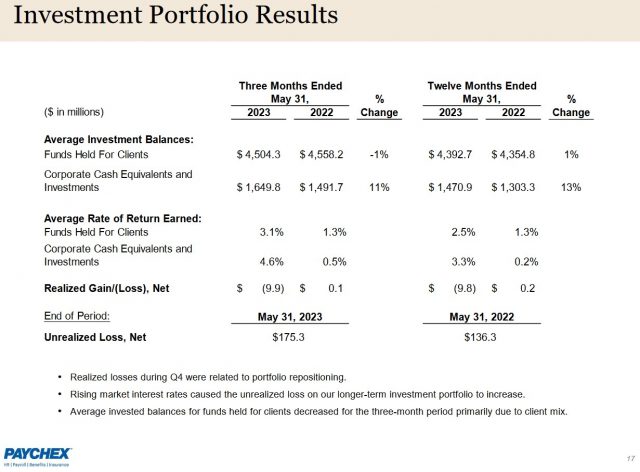
Source: PAYX - Q4 2023 Earnings Presentation
The Investment Portfolio results at the end of Q3 2023 are provided below for comparison purposes.
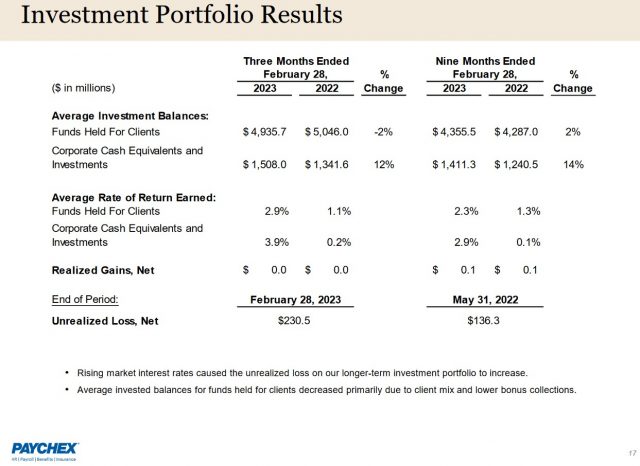
Source: PAYX - Q3 2023 Earnings Presentation - March 29, 2023
FY2024 Outlook
The FY2024 outlook takes into account some uncertainty surrounding future interest rate changes. PAYX will have better visibility into the remaining quarters as the year progresses. We should, therefore, expect quarterly adjustments as the fiscal year progresses.
For the first half of FY2024 and Q1, however, management expects total revenue growth of ~6% and the expectation for the Q1 operating margin is ~41%.

Source: PAYX - Q4 2023 Earnings Presentation
For comparison purposes, I include PAYX's original FY2023 outlook and subsequent quarterly revisions.
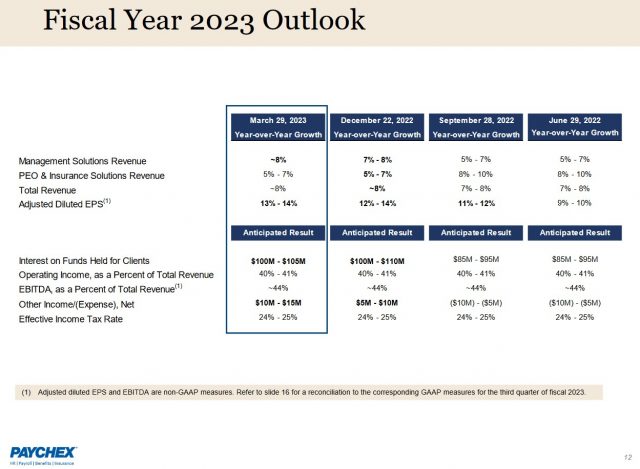
Source: PAYX - Q3 2023 Earnings Presentation - March 29, 2023
Risk Assessment
No rating agency rates PAYX's debt. Looking at the consolidated Balance Sheet (page 12 in Form 8-K), however, we see that PAYX's risk is low.
It had current assets before funds held for clients of ~$3.409B of which ~$1.595B was cash, cash equivalents, and corporate investments and ~$1.426B was Accounts Receivable, net of allowance for credit losses and PEO unbilled receivables, net of advance collections.
At FYE2023, PAYX's Current Assets before funds held for clients were more than 2.25x Current Liabilities before client fund obligations.
Total short-term and long-term borrowings of ~$0.808B are similar to prior recent quarters. On March 13, 2019, PAYX completed the private placement of Senior Notes, Series A in an aggregate principal amount of $0.4B due on March 13, 2026, and Senior Notes, Series B in an aggregate principal amount of $0.4B due on March 13, 2029.

Source: PAYX - Q3 2023 Form 10-Q
Proceeds from the Notes were used to pay off $0.8B in short-term borrowings under its JP Morgan credit facilities used to temporarily finance the Oasis acquisition; Oasis was the US's largest privately-owned professional employer organization (PEO) and an industry leader in providing human resources outsourcing services.
Details of PAYX's financing arrangements commence on page 26 in the Q3 2023 Form 10-Q.
Dividends and Dividend Yield
At the time of my January 22, 2022 post, shares were trading at $118.67 and the $0.66 quarterly dividend yielded ~2.22%.
On April 29, 2022, PAYX declared a 20% increase in its quarterly dividend from $0.66 to $0.79. When I wrote my June 30, 2022 post, shares were trading at ~$114 thus resulting in a ~2.77% dividend yield.
When I wrote my December 23 post, shares were trading at ~$112.18. I expected the 4th quarterly $0.79 dividend to be declared in mid-January 2023 for distribution near the end of February. I anticipated a ~$0.04 - ~$0.06 dividend increase would be declared toward the end of April for distribution in late May. Using a $0.05 increase, I projected that the subsequent 4 quarterly dividend payments would total $3.31 ($0.79 + (3 x $0.84)) thus giving us a forward dividend yield of ~2.95%.
In my March 30 post, I wrote that PAYX's fiscal year-to-date (February 28, 2023) dividend coverage ratio of 1.4x was the strongest it had been since the 1.5x fiscal year-to-date result was reported as of May 31, 2020. I, therefore, felt there was no reason to expect a dividend increase below $0.05/share/quarter. With shares trading at ~$116 and the possibility of the quarterly dividend being increased to $0.84, I calculated a forward dividend yield of ~2.9% based on the subsequent 4 quarterly dividend payments amounting to $3.36.
On April 28, however, PAYX declared a 13% increase in its quarterly dividend from $0.79 to $0.89.
With shares having closed at $109.33 on June 29, the forward dividend yield is ~3.26%.
The weighted average number of diluted shares outstanding (in millions rounded) is 363, 365, 366, 365, 363, 363, 362, 362, 361, 362, 363, and 362.3 in FY2012 - FY2023.
PAYX maintains a program to repurchase up to $0.4B of common stock, with authorization expiring on January 31, 2024. The purpose of this program is to manage common stock dilution. Much like many other companies, PAYX issues shares under its employee compensation structure. This explains why there is very little change in the weighted average number of shares outstanding despite the repurchase of shares outstanding.
PAYX repurchased no shares in FY2023 and $327.1 million remains available for share repurchases in total under the program.
In comparison, PAYX repurchased:
- 1.2 million shares for a total of $145.2 million in FY2022;
- 1.7 million shares for a total of $155.7 million at an average price of $90.83 in FY2021; and
- 2 million shares for a total of $171.9 million at an average price of $84.68 in FY2020.
Valuation
PAYX's FY2012 - FY2022 diluted PE levels are 20.19, 28.28, 26.08, 26.31, 28.32, 29.34, 23.44, 28.54, 31.80, 38.78, and 28.53.
At the time of my January 22, 2022 post, the following were the forward-adjusted diluted PE levels using earnings estimates from the two online trading platforms I use.
- FY2022 - 16 brokers - mean of $3.63 and low/high of $3.59 - $3.68. Using the mean estimate, the forward adjusted diluted PE was ~33 and ~32 if I used $3.68.
- FY2023 - 18 brokers - mean of $3.89 and low/high of $3.70 - $4.08. Using the mean estimate, the forward adjusted diluted PE was ~30.5 and ~29 if I used $4.08.
- FY2024 - 10 brokers - mean of $4.20 and low/high of $4.05 - $4.42. Using the mean estimate, the forward adjusted diluted PE was ~28.3 and ~26.8 if I used $4.42.
I concluded that PAYX's current valuation was slightly high.
When I wrote my June 30, 2022 post, PAYX had just reported $3.84 in diluted EPS and $3.77 in adjusted diluted EPS. With shares trading at ~$114, the diluted PE was ~29.7 and the adjusted diluted PE was ~30.2.
Management's FY2023 outlook called for a 9% - 10% increase in adjusted diluted EPS (~$4.11 - ~$4.15). Using the ~$114 share price, the forward adjusted diluted PE range was ~27.5 - ~27.7.
I expected revisions to earnings estimates from the brokers which cover PAYX after my review. Based on currently available estimates, however, the forward adjusted diluted PE levels were:
- FY2023 - 19 brokers - mean of $4.13 and low/high of $4.03 - $4.17. Using the mean estimate, the forward adjusted diluted PE was ~27.6 and ~27.3 if I used $4.17.
- FY2024 - 17 brokers - mean of $4.43 and low/high of $4.10 - $4.62. Using the mean estimate, the forward adjusted diluted PE was ~25.7 and ~24.7 if I used $4.62.
When I wrote my December 23, 2022 post, PAYX had generated $2.04 in diluted EPS and $2.02 in adjusted diluted EPS in the first half of FY2023. The most current FY2023 adjusted diluted EPS outlook called for 12% - 14% growth from FY2022 or ~$4.22 - ~$4.30. Using a ~$4.26 mid-point and the current ~$112.18 share price, the forward adjusted diluted PE was ~26.3.
Using the available broker estimates, the forward adjusted diluted PE levels were:
- FY2023 - 18 brokers - mean of $4.24 and low/high of $4.13 - $4.28. Using the mean estimate, the forward adjusted diluted PE was ~26.5 and ~26.2 if I used $4.28.
- FY2024 - 18 brokers - mean of $4.53 and low/high of $4.30 - $4.74. Using the mean estimate, the forward adjusted diluted PE was ~24.8 and ~23.7 if I used $4.74.
- FY2025 - 10 brokers - mean of $4.88 and low/high of $4.66 - $5.06. Using the mean estimate, the forward adjusted diluted PE was ~23 and ~22.2 if I used $5.06.
When I wrote my March 30 post, PAYX's FY2023 outlook called for 13% - 14% YoY growth in adjusted diluted EPS; PAYX generated $3.84 and $3.77 in diluted EPS and adjusted diluted EPS in FY2022.
Using a 13.5% growth for both GAAP and non-GAAP EPS, I arrived at ~$4.36 in FY2023 diluted EPS and ~$4.28 in adjusted diluted EPS. These estimates appeared achievable considering PAYX had generated $3.33 in diluted EPS and $3.31 in adjusted diluted EPS in the first 9 months of FY2023. Using these estimates and with shares trading at ~$116, the forward diluted PE was ~26.6 and the forward adjusted diluted PE was ~27.1.
The forward adjusted diluted PE levels based on the currently available broker estimates were:
- FY2023 - 19 brokers - mean of $4.26 and low/high of $4.14 - $4.33. Using the mean estimate, the forward adjusted diluted PE is ~27.2.
- FY2024 - 19 brokers - mean of $4.56 and low/high of $4.31 - $4.68. Using the mean estimate, the forward adjusted diluted PE is ~25.4.
- FY2025 - 11 brokers - mean of $4.91 and low/high of $4.64 - $5.05. Using the mean estimate, the forward adjusted diluted PE is ~23.6.
We now know that PAYX generated $4.30 in diluted EPS and $4.27 in adjusted diluted EPS in FY2023. With shares currently trading at $109.33, the diluted PE is ~25.4 and the adjusted diluted PE is ~25.6.
The FY2024 outlook calls for a 9% - 10% increase in adjusted diluted EPS. Using the 9.5% mid-point, FY2024 adjusted diluted EPS is expected to be ~$4.68. With shares currently trading at $109.33, the forward adjusted diluted PE is ~23.4.
The forward adjusted diluted PE levels based on the currently available broker estimates are:
- FY2024 - 20 brokers - mean of $4.65 and low/high of $4.35 - $4.71. Using the mean estimate, the forward adjusted diluted PE is ~23.5.
- FY2025 - 18 brokers - mean of $4.97 and low/high of $4.86 - $5.11. Using the mean estimate, the forward adjusted diluted PE is ~22.
Final Thoughts
PAYX benefits from an increasingly complex regulatory environment, a tight labour market, and a growing adoption of hybrid work models which should drive demand for its offerings; this includes add-on human capital management modules and human resources outsourcing solutions. It does, however, operate in a highly competitive market. As a result, PAYX will need to maintain high levels of investment to ensure the functionality of its product suite is comparable with peers and meets client demands.
PAYX's customer base consists of 740,000+ small- and medium-sized businesses across the U.S. and parts of Europe. Many could go out of business if the economies in which PAYX operates slip into a recession. The risk of significant credit losses, however, is minimal in that PAYX typically receives funds before it must disburse funds or it has a Standby Letter of Credit (typically from a reputable financial institution) which can be drawn upon in the event the client is unable to fund its payroll.
At FYE2023, PAYX had ~$2.759B of Total Liabilities when we exclude client fund obligations. Meanwhile, it had ~$3.022B in cash and cash equivalents, corporate investments, interest receivable, accounts receivable (net of allowance for credit losses), and PEO unbilled receivables (net of advance collections). PAYX could easily use some of its liquidity to repay a portion of the outstanding Senior Notes. However, the terms of the Senior Notes are sufficiently attractive that management does not view this to be the optimal means of capital deployment.
I have been a PAYX shareholder since July 8, 2009 and have periodically added to my exposure when I considered shares to be attractively valued. Based on my current analysis, I consider low-risk Paychex to currently be attractively valued. However, my PAYX exposure now consists of 717 shares (283 and 434 shares in a 'Core' and a 'Side' account, respectively) in the FFJ Portfolio and I am looking to increase my exposure in other holdings. I, therefore, do not intend to acquire additional PAYX shares at this point.
I wish you much success on your journey to financial freedom!
Note: Please send any feedback, corrections, or questions to [email protected].
Disclosure: I am long PAYX.
Disclaimer: I do not know your circumstances and do not provide individualized advice or recommendations. I encourage you to make investment decisions by conducting your own research and due diligence. Consult your financial advisor about your specific situation.
I wrote this article myself and it expresses my own opinions. I do not receive compensation for it and have no business relationship with any company mentioned in this article.

